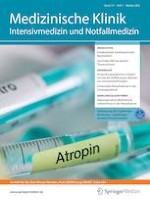Erschienen in:

09.04.2021 | Kardiopulmonale Reanimation | Übersichten
Extrakorporale kardiopulmonale Reanimation (eCPR)
verfasst von:
Dr. med. K. Pilarczyk, G. Michels, S. Wolfrum, G. Trummer, N. Haake
Erschienen in:
Medizinische Klinik - Intensivmedizin und Notfallmedizin
|
Ausgabe 7/2022
Einloggen, um Zugang zu erhalten
Zusammenfassung
Die extrakorporale kardiopulmonale Reanimation („extracorporeal cardiopulmonary resuscitation“, eCPR) ist seit 2015 Bestandteil der ERC-Reanimationsleitlinien und kann als Therapieoption für hochselektierte Patienten mit refraktärem Herz-Kreislauf-Stillstand und potenziell reversibler Ätiologie erwogen werden. Es darf allerdings nicht außer Acht gelassen werden, dass es sich hierbei um eine sehr komplexe Therapie handelt, die enorme Ressourcen und ein hohes fachliches Wissen in allen Berufsgruppen erfordert und viele Risiken in sich birgt. Aktuell fehlen allerdings randomisiert-kontrollierte Studien zur eCPR und es existieren nur begrenzt valide Prädiktoren, die bei der Indikationsstellung hilfreich sein könnten, sodass sowohl Indikationsstellung als auch das konkrete Vorgehen klinikspezifisch und nicht standardisiert sind. Mit zunehmender Verfügbarkeit dieser Therapieoption besteht allerdings beim medizinischen Fachpersonal sowohl klinisch als auch präklinisch, das regelhaft in erweiterte Reanimationsmaßnahmen eingebunden ist, Unsicherheit hinsichtlich medizinischer und organisatorischer Fragen zur praktischen Umsetzung im konkreten Einsatzfall. Allerdings sind insbesondere an der Schnittstelle zwischen Rettungsdienst und Klinik eine klare Kommunikation und fest definierte Prozesse erforderlich, um das optimale Ergebnis für den Patienten zu erzielen.
Ziel des vorliegenden Artikels ist es, für die Arbeit in der Notaufnahme einen grundlegenden Algorithmus für die Indikationsstellung, Vorbereitung, ECLS-Implantation und Versorgung nach eCPR vorzustellen. Dieser orientiert sich im Wesentlichen an dem im Jahre 2019 publizierten Konsensuspapiers zur eCPR der DGIIN, DGK, DGTHG, DGfK, DGNI, DGAI, DIVI und GRC, der aktuellen S3-Leitlinie „Einsatz der extrakorporalen Zirkulation (ECLS/ECMO) bei Herz- und Kreislaufversagen“ sowie den klinikinternen SOPs der Autoren.